The Dell XPS 13 7390 2-in-1 Review: The Ice Lake Cometh
by Brett Howse on November 15, 2019 11:30 AM ESTDisplay Analysis
Dell offers two display options. The review unit arrived with the first option: a 1920x1200 sRGB display, offering pen and touch support. Dell also offers a 3840x2400 P3-D65 panel, which delivers a higher resolution image with a wider color gamut, but as we've seen time and time again, will come with a stiff hit to battery life. Both feature bonded Corning Gorilla Glass 5 as well, for added durability. In addition, the displays feature a good anti-reflective coating, which is rated at 0.65% reflectivity. This means more viewing of what’s on the display, and less viewing of what’s in the room.
The move back to a taller screen provides a lot of benefits in the laptop space, where doing work often involves the vertical axis. Scrolling spreadsheets or webpages are two basic examples of an added benefit of more vertical pixels, and while it may not seem like a big change to go from 16:9 like most laptops to 16:10, in use it is a very welcome change. It also eliminates the large chin found on the bottom of most laptop displays, and Dell has stretched out the 13.3-inch on the outgoing XPS 13 to a slightly larger 13.4 in the same footprint, without increasing the size of the laptop itself.
The base display offers 169 pixels-per-inch (PPI) pixel density, which, while still well above the standard 92 PPI of old, doesn’t match the Surface Laptop 3, as an example. But it still offers plenty of resolution for most tasks, and with the added benefit of offering better battery life. But if you do want lots of PPI the 4K option will of course double the PPI to 338, at the cost of money and battery life.
Dell also offers Dolby Vision on both panels, but Dolby Vision on laptops is not what you may think. It will support Dolby Vision video playback in Netflix, but it doesn’t transform the display into an HDR offering. It just works to provide the best picture it can with the hardware available. On the 4K panel though, Dell is offering P3-D65 gamut support as well as HDR 400 certification. It should be a fantastic display in certain scenarios, but be warned that Windows is fairly hamstrung on support for HDR, and especially wide-gamut displays, since its color management is fairly limited.
To see how the display performed, we tested it with Portrait Display’s SpectraCal software with a custom workflow. Brightness and contrast were measured with the X-Rite i1Display Pro colorimeter, and color accuracy was tested with the X-Rite i1Pro2 spectrophotometer.
Brightness and Contrast
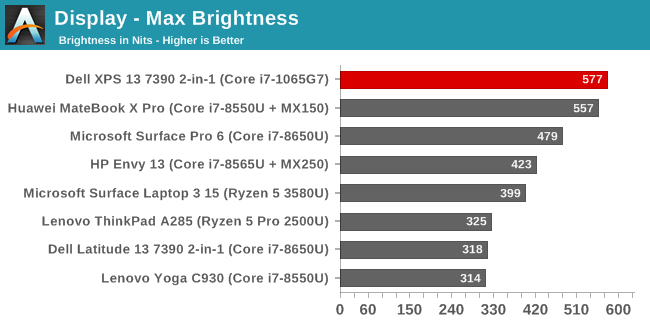
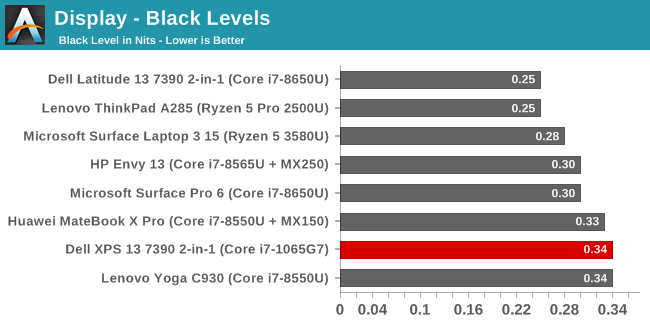
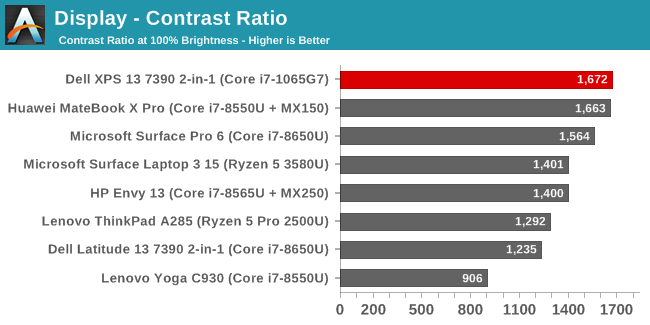
The XPS 13 can get exceptionally bright, closing in on 600 nits, while at the same time offering almost 1700:1 contrast ratio. These are fantastic results for a laptop, and especially one that is this portable since it should work well even under bright conditions. If it had a downside, it would be that the display only dims to 27 nits (white), which is far too bright to use as a tablet in bed.
Grayscale
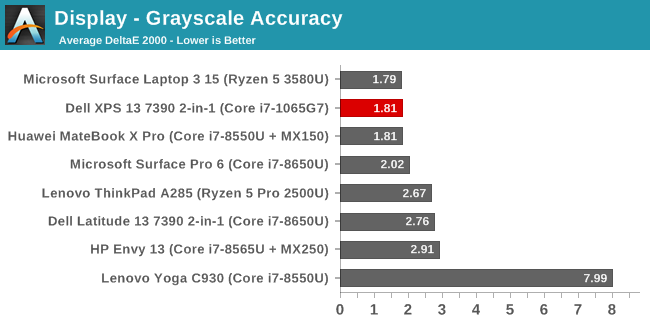
Dell has upped their game significantly with the XPS 13 7390. Clearly they’ve employed some color calibration, since the display’s grayscale accuracy is almost perfect, with no error levels over 3.0, and a gamma that closely matches the 2.2 target. The display is slightly cool in its white point, but overall it is a great result.
Gamut
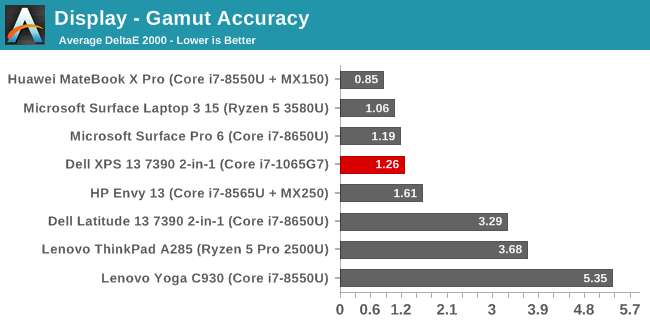
Testing the display at 100% levels for the primary and secondary colors shows that Dell has taken their color seriously on this laptop. It pretty much perfectly matches the sRGB color gamut, with great accuracy on all of the colors. All of the results are well under the 3.0 level we consider to be accurate, and most are under the 1.0 level we’d consider imperceptible.
Saturation
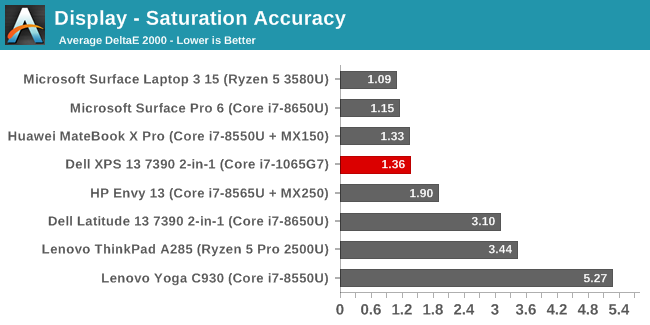
The saturation sweeps run all of the primary and secondary colors in 4-bit steps from 0% to 100% brightness. The results are nearly perfect, and well under the 3.0 level across the entire range on all six colors.
Gretag Macbeth
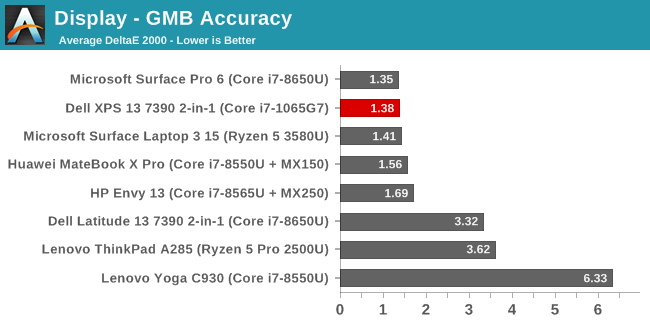
Our final test is the Gretag Macbeth, with tests a variety of colors outside of the primary and secondary axis, and including the important skin tones. None of the tested color points were really even over the 2.0 error level. This is a great result.
Colorchecker
This shows the relative error level with the target color on the bottom, and the displayed color on the top. Overall the results are near-perfect.
Display Conclusion
The XPS 13 offers one of the best displays on any notebook we’ve tested. The move back to the taller 16:10 aspect ratio is most welcome, and it’s been refreshing to see some manufacturers utilize taller displays such as the 3:2 and 16:10 when it used to be almost impossible to find anything that was not 16:9. The aspect is even more important when you consider this is a convertible laptop, and 16:9 does not work very well as a tablet.
Dell also offers an excellent anti-reflective coating, which will hopefully spur on their competitors to follow suit. This is something Apple’s iPad range has excelled at for some time, but many PCs still have either a matte coating to scatter the light, which also reduces the sharpness of the image, or very reflective glass coatings which are sharp but hard to use outside. The XPS 13 7390 offers both a very bright, and a low reflectivity coating, meaning it should excel in bright environments.
Finally, Dell has calibrated the display, meaning the colors on the XPS 13 are almost perfect.
This combination is a big win for the XPS 13, and provides it yet another area where it excels over its competition.















108 Comments
View All Comments
Alistair - Saturday, November 16, 2019 - link
Well I'm going with the Surface Laptop instead. Wish me luck ;)Qasar - Saturday, November 16, 2019 - link
he would suggest the intel based laptop no matter what. so dont be too hurt, alistair :-)HStewart - Monday, November 18, 2019 - link
Well you can go have you Windows for ARM piece of junk. As for Ryzen, it your choice just don't try to tell others that they should go for Ryzen also. I don't care if you go for AMD,. just don't try to tell me. People have the right to choose what they want to go.Korguz - Monday, November 18, 2019 - link
HStewart " As for Ryzen, it your choice just don't try to tell others that they should go for Ryzen also " right after you dont tell people to go for intel. as you said, "People have the right to choose what they want to go. "Reflex - Monday, November 18, 2019 - link
Ryzen is awesome in the desktop, workstation and server space. In mobile it's mediocre but on the rise. I have no hesitation recommending Ryzen for anyone outside of mobile. Anyone pushing Intel on the desktop while ignoring the alternative is performing a disservice to their friends/clients.HStewart - Friday, November 15, 2019 - link
One thing that would be fun to see if i7 version of this XPS 13 2in1 compare to older generation, which it would be a total wash. But also the XPS 15 2in1 which I would think it would actually give a run for the money. To bad Intel does not have H versions of Ice Lake ready... maybe early 2020.lazarpandar - Friday, November 15, 2019 - link
"It’s difficult to understate how important the XPS 13 is to Dell’s lineup, and to the industry as a whole."You mean overstate here. The implication being, even if you use really grandiose language, it'd be difficult to overdo it. If something's importance is difficult to understate, you mean, you can hardly even find the words to describe how unimportant it is.
not_anton - Monday, November 18, 2019 - link
It’s difficult to understate how Dell could try to rip-off a 13” macbook pro and still fail after all these years. At least they managed to copy 16:10 screen aspect ratio... but look at these hideous bottom air ducts copied from a macbook - except that macbook hides them in a cutout in aluminium case.Reflex - Monday, November 18, 2019 - link
Macbooks look like premium laptops from ten years ago. They long ago lost their lead in this space.ikjadoon - Friday, November 15, 2019 - link
> Ice Lake also brings some major improvements to wake from sleep, and finally brings the laptop into the same range as tablets and smartphones when waking them.Is this benchmarkable? I'd love to see time-to-wake tested between laptops. It's a small, but vastly underrated improvement.
I move around w/ my laptop often and I'd love to see wake time quantified.
It'd be a good proxy benchmark for platform optimization, which (besides battery life & thermals) is hard to tease out.